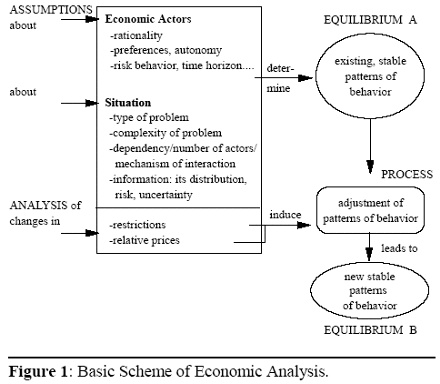A main methodological characteristic of the standard economic approach is its focus on the analysis of changes in patterns of behavior (in terms of quantities produced, consumed, exchanged etc.) as a reaction to changes in restrictions or relative prices. Based on a bundle of assumptions that form the core of the theory, the analysis typically begins with the specification of situation variables that predetermine stable patterns of (equilibrium) behavior.
Next, restrictions or relative prices are assumed to change, thereby inducing an adjustment process that leads to new equilibrium behavior. As discussed above, the adjustment process itself has traditionally been treated as a black box, and perfect conditions for this process are assumed implicitly. Figure 1 shows this basic scheme of economic analysis.
The theory core consists of strong assumptions about the economic actors (i.e., about rationality, preferences, autonomy).[42] Additional assumptions about the actors’ risk behavior, patience, time horizon, etc. may be introduced depending on the situation being modeled. This situation is generally defined by the type and complexity of the problem,[43] the number of involved actors,[44] and assumptions about information.[45] These assumptions and definitions taken together determine the starting equilibrium (A, in Figure 1) as existing, stable patterns of behavior in terms of quantities.

The analysis then proceeds by introducing some exogenous stimulus in terms of changes in restrictions or relative prices that induces actors to adjust their patterns of behavior, eventually leading to new and again stable patterns of behavior (equilibrium B, Figure 1). In learning models, this basic scheme is extended by introducing an adjustment mechanism that allows to distinguish between equilibria (B) for the case where several equilibria emerge.
As discussed above, this is a way to “open the black box” of behavior adjustment, but one that may turn out to be problematic, especially when it comes to empirical testing due to the reasons already mentioned. Thus, an alternative way to approach learning in economics may be to “keep the black box closed”, and to identify the conditions for learning and the limits imposed by these conditions instead.[46] Henceforth, this idea will be referred to as contingent learning.
To acknowledge and analyze conditions for, and limits of learning as situational constraints may be viewed as similar to the introduction of cognitive constraints in models of bounded rationality put forward by Herbert Simon and others.[47] That is, whereas models of bounded rationality relax the strong rationality assumption based on findings in cognitive science, a model of contingent learning aims to loosen the strong learning assumptions in order to provide a basis for richer economic models. Hence, contingent learning should be seen as a supplementary approach that may fruitfully be combined with existing economic theories and with bounded rationality models, not as their substitute.
In a behavioral view, the actual behavior of economic actors results from the interplay of cognitive factors on the one hand and situational factors on the other.[48] Economics has quite successfully focussed on rather extreme and specific forms of both types of factors. The mentioned problems of existing learning theory seem to suggest that analysis may not only be extended to include cognitive factors, but also additional situational factors in a behavioral – not behavioristic – sense.
As for the contingent learning approach described in the next section, standard assumptions about economic actors will mainly be maintained,[49] but the analysis of situational factors is extended by including determinants of learning processes. These determinants can be regarded as situational constraints that supplement the traditional economic restrictions. They reflect robust findings from psychology, and will be employed to account for the criticism presented in the previous section.
42 Traditionally, the core also involves that the situation is one of scarcity. Although scarcity is a conditio sine qua non for economics, and for the definition of rationality, it can be constructed by various stories in virtually any situation so that it becomes an almost empty concept (at least in terms of methodology).
43 The “type” of problem may be one of consumption, production, investment, etc., whereas its “complexity” denotes the number of alternatives available, or dimensions of the problem for a given type of problem (e.g., an investment problem may be modeled more or less complex depending on alternatives and dimensions of the investment).
44 This number is rather important in economic analysis because it determines the degree of dependency among actors and the mechanism of interaction (see Section 4 for more details).
45 This includes assumptions about the distribution of information among actors, and a definition of the situation as one of certainty, risk, or uncertainty.
46 The more fundamental problem that economists face when trying to incorporate learning in economic models, may be analogous to the problem psychologists face when analyzing cognitive processes (see e.g., CATANIA [1992, 7]): Since learning (alike cognition) cannot be observed as such or directly, empirically based theories can be derived only from observable behavior, thereby leading to a variety of problems of induction.
47For a recent survey see CONLISK (1996).
48 As HEINER (1983) has argued, predictable behavior may result from the individuals’ attempt to bridge what he calls the competence-difficulty-gap.
49 That is, (i) actors are assumed to be rational without any attributes, and (ii) methodological individualism is retained.
Prof. Tilman Slembeck
Next: Contingent Learning
Summary: Index